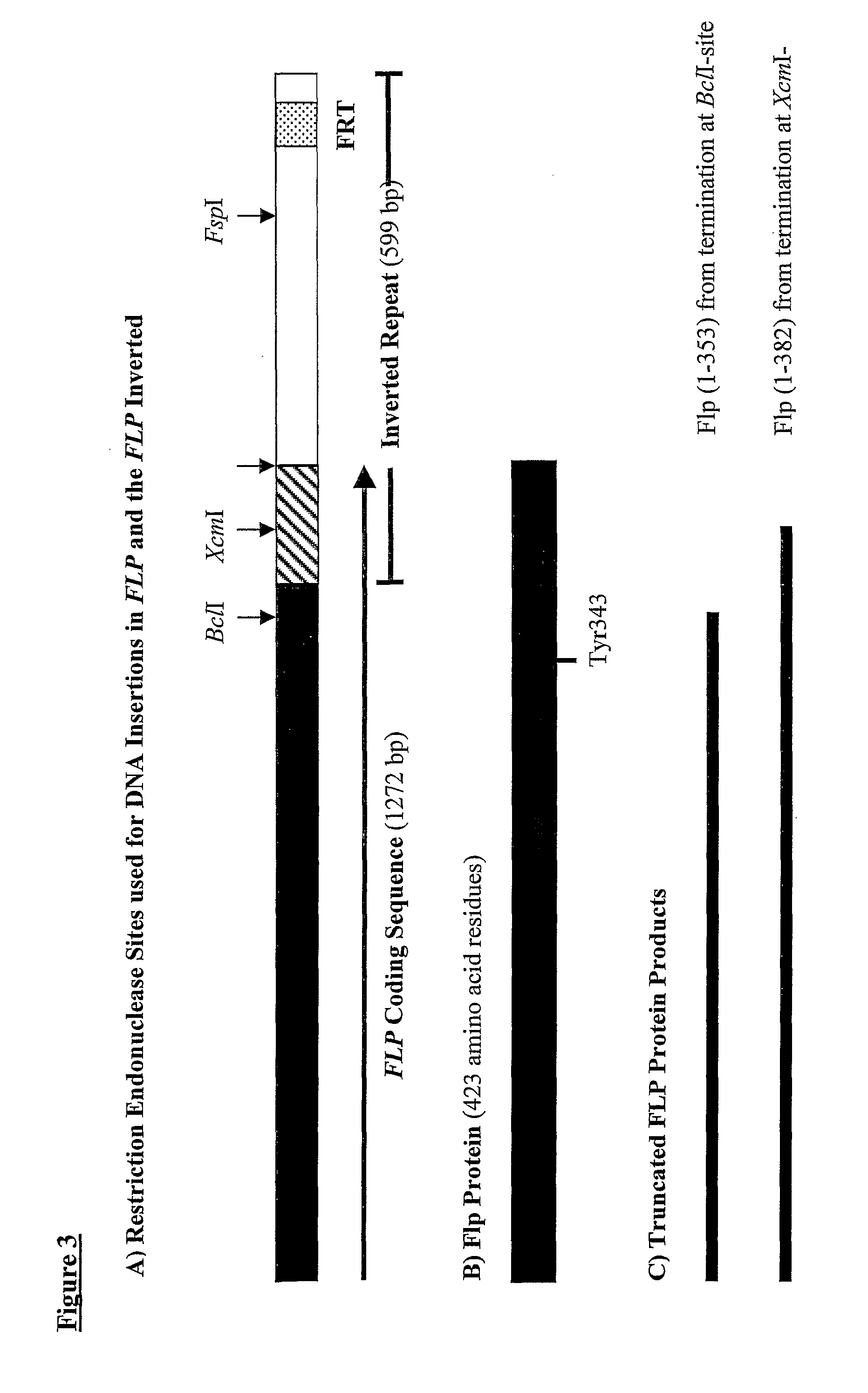Gene Expression Technique
a gene expression and gene technology, applied in the field of gene expression techniques, can solve the problems of affecting yeast growth and plasmid stability, having a detrimental effect on heterologous protein secretion, and limiting the rate of transfer from the er to the golgi
- Summary
- Abstract
- Description
- Claims
- Application Information
AI Technical Summary
Problems solved by technology
Method used
Image
Examples
example 1
Construction of Expression Plasmids
[0329] A 52-bp linker made by annealing 0.5 mM solutions of oligonucleotides CF86 and CF87 (see below) was introduced into the US-region of the 2 μm plasmid pSAC35 at the XcmI-sites in the 599-bp inverted repeats. One XcmI-site cuts 51-bp after the REP2 translation termination codon, whereas the other XcmI-site cuts 127-bp before the end of the FLP coding sequence, due to overlap with the inverted repeat (see FIG. 3). This DNA linker contained a core region “SnaBI-PacI-FseI / SfiI-SmaI-SnaBI”, which encoded restriction sites absent from pSAC35.
XcmI Linker (CF86 + CF87) SfiI -------------- PacI SnaBI --------- ------- SnaBT FseI SmaI ------- -------- ------CF86 GGAGTGGTA CGTATTAATT AAGGCCGGCC AGGCCCGGGT ACGTACCAAT TGACF87TCCTCACCAT GCATAATTAA TTCCGGCCGG TCCGGGCCA TGCATGGTTA AC
[0330] Plas...
example 2
Expression of Transferrin
[0339] A S. cerevisiae control strain was transformed to leucine prototrophy with all the transferrin (N413Q, N611Q) expression plasmids, and cryopreserved stocks were prepared.
[0340] Strains were grown for four days at 30° C. in 10 mL BMMD cultures in 50 mL conical flasks shaken at 200 rpm. The titres of recombinant transferrin secreted into the culture supernatants were compared by rocket immunoelectrophoresis (RIE as described in Weeke, B., 1976, “Rocket immunoelectrophoresis” In N. H. Azelsen, J. Kroll, and B. Weeke [eds.], A manual of quantitative immunoelectrophoresis. Methods and applications. Universitetsforlaget, Oslo, Norway), reverse phase high performance liquid chromatography (RP-HPLC) (Table 2), and non-reducing SDS polyacrylamide electrophoresis stained with colloidal Coomassie blue stain (SDS-PAGE). The increase in recombinant transferrin secreted when S. cerevisiae PDI1 was over-expressed was estimated to be greater than 10-fold.
TABLE 2A...
example 3
Chromosomal Over-Expression of PDI
[0344]S. cerevisiae Strain A was selected to investigate the secretion of recombinant glycosylated transferrin expression from plasmid pDB2506 and recombinant non-glycosylated transferrin (N413Q, N611Q) from plasmid pDB2536. Strain A has the following characteristics—[0345] additional chromosomally integrated PDI1 gene integrated at the host PDI1 chromosomal location. [0346] the URA3 gene and bacterial DNA sequences containing the ampicillin resistance gene were also integrated into the S. cerevisiae genome at the insertion sites for the above genes.
[0347] A control strain had none of the above insertions.
[0348] Control strain [cir0] and Strain A [cir0] were transformed to leucine prototrophy with pDB2506 (recombinant transferring, pDB2536 (recombinant non-glycosylated transferrin (N413Q, N611Q)) or pSAC35 (control). Transformants were selected on BMMD-agar.
[0349] The relative level of transferrin secretion in BMMD shake flask culture was determ...
PUM
| Property | Measurement | Unit |
|---|---|---|
| length | aaaaa | aaaaa |
| size | aaaaa | aaaaa |
| PDI | aaaaa | aaaaa |
Abstract
Description
Claims
Application Information
 Login to view more
Login to view more - R&D Engineer
- R&D Manager
- IP Professional
- Industry Leading Data Capabilities
- Powerful AI technology
- Patent DNA Extraction
Browse by: Latest US Patents, China's latest patents, Technical Efficacy Thesaurus, Application Domain, Technology Topic.
© 2024 PatSnap. All rights reserved.Legal|Privacy policy|Modern Slavery Act Transparency Statement|Sitemap



